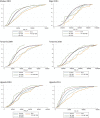Are African households (not) leaving agriculture? Patterns of households' income sources in rural Sub-Saharan Africa
- PMID: 28413253
- PMCID: PMC5384437
- DOI: 10.1016/j.foodpol.2016.09.018
Are African households (not) leaving agriculture? Patterns of households' income sources in rural Sub-Saharan Africa
Abstract
This paper uses comparable income aggregates from 41 national household surveys from 22 countries to explore the patterns of income generation among rural households in Sub-Saharan Africa, and to compare household income strategies in Sub-Saharan Africa with those in other regions. The paper seeks to understand how geography drives these strategies, focusing on the role of agricultural potential and distance to urban areas. Specialization in on-farm activities continues to be the norm in rural Africa, practiced by 52 percent of households (as opposed to 21 percent of households in other regions). Regardless of distance and integration in the urban context, when agro-climatic conditions are favorable, farming remains the occupation of choice for most households in the African countries for which the study has geographically explicit information. However, the paper finds no evidence that African households are on a different trajectory than households in other regions in terms of transitioning to non-agricultural based income strategies.
Keywords: Africa; Agriculture; Income; LSMS; Non-farm employment.
Figures






















References
-
- Azzarri C., Carletto C., Davis B., Fatchi T., Vigneri M. Background Paper Prepared for the World Bank Malawi Poverty and Vulnerability Assessment. FAO; Rome: 2006. Food and nutrition security in Malawi.
-
- Barrett C., Reardon T., Webb P. Nonfarm income diversification and household livelihood strategies in Rural Africa: concepts, dynamics and policy implications. Food Policy. 2001;26(4)
-
- Bezu S., Barrett C. Employment dynamics in the rural nonfarm sector in Ethiopia: do the poor have time on their side? J. Develop. Stud. 2012;48(9):1223–1240.
-
- Bezu S., Barrett C., Holden S. Does nonfarm economy offer pathways for upward mobility? World Develop. 2012;40(8):1634–1646.
-
- Binswanger-Mkhize H.P., McCalla A.F., Patel P. Structural transformation and African agriculture. Global J. Emerg. Market Econ. 2010;2:113–152.
LinkOut - more resources
Full Text Sources
Other Literature Sources
